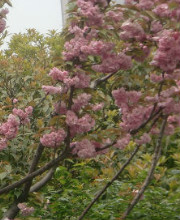| 图片: | |
|---|---|
| 名称: | |
| 描述: | |
- 上次马老师讲课我所问的病例
Overall this is a high grade glioma (WHO grade III anaplastic astrocytoma or mixed oligoastrocytoma) glioma or WHO grade IV glioblastoma. Focally there are relatively uniform cells with perinuclear halos, raising the possibility of an oligodendroglioma component. However, there are no delicate capillaries, mucinous microcysts, myxoid background, calcification or minigemistocytes to support this possibility for sure. On the other hand, there are many pleomorphic astrocytes in hypercellular areas. I am not certain from the photos (which are compressed to too small a size, by the way) whether there are easily recognized mitotic figures, necrosis or vascular proliferation or not. Though the lesion is focally cystic, it has an ill-demarcated margin on MRI. MIB-1 LI of 15% is not that of a low grade neoplasm. If there is easily seen mitotic figures, and necrosis and/or vascular proliferation is present, this would qualified as WHO glioblastoma. That said, pleomorphic xanthoastrocytoma with anaplastic features (WHO grade III) needs to be ruled out. Finding eosinophilic granular bodies in the tumor would support this possibility. Therefore I think you should look for the following things: mitotic figures (how easy it is to find them), necrosis, vascular proliferation, eosinophilic granular bodies, calcification, and dysplastic large neurons, By the way, small uniform cells with perinuclear halos can be seen focally in otherwise classic glioblastomas.

聞道有先後,術業有專攻
Overall this is a high grade glioma (WHO grade III anaplastic astrocytoma or mixed oligoastrocytoma) glioma or WHO grade IV glioblastoma. 总体来说,本例是一高级别的胶质瘤(WHO III级的间变性星形细胞瘤或混合性少突星形细胞瘤。),Focally there are relatively uniform cells with perinuclear halos, raising the possibility of an oligodendroglioma component.局部有相对一致的细胞伴有核周空晕,让人考虑可能有少突胶质细胞瘤的成份。 However, there are no delicate capillaries, mucinous microcysts, myxoid background, calcification or minigemistocytes to support this possibility for sure. 但是没有纤细的毛细胞血管,没有粘液性微囊肿,没有粘液样背景,没有钙化,也没有微小肥胖细胞,因此这种可能性不大。On the other hand, there are many pleomorphic astrocytes in hypercellular areas. 相反,在细胞丰富的区域,有许多多形性星形细胞。I am not certain from the photos (which are compressed to too small a size, by the way) whether there are easily recognized mitotic figures, necrosis or vascular proliferation or not. 因图片压缩较小,不敢肯定有无核丝分裂、坏死和血管增生。Though the lesion is focally cystic, it has an ill-demarcated margin on MRI.核磁片病变呈囊性,但边缘界线不清, MIB-1 LI of 15% is not that of a low grade neoplasm. MIB-115%已经不是低级别肿瘤。If there is easily seen mitotic figures, and necrosis and/or vascular proliferation is present, this would qualified as WHO glioblastoma.如果非常容易看到核丝分裂、坏死和血管增生,可肯定为WHO的胶质母细胞瘤。 That said, pleomorphic xanthoastrocytoma with anaplastic features (WHO grade III) needs to be ruled out.需要排除有间变的多形性黄色星形细胞瘤。 Finding eosinophilic granular bodies in the tumor would support this possibility. 若能在肿瘤中找到嗜酸性颗粒小体,可以支持诊断。Therefore I think you should look for the following things:我认为你应该找下述几种形态: mitotic figures (how easy it is to find them), necrosis, vascular proliferation, eosinophilic granular bodies, calcification, and dysplastic large neurons,找核丝分裂(很容易找到)、坏死、血管增生、嗜酸颗粒小体、钙化和结构不良的大神经元细胞。 By the way, small uniform cells with perinuclear halos can be seen focally in otherwise classic glioblastomas.顺便说一句,局部见到小而一致的具有核周空晕的细胞是典型的胶质母细胞瘤。






















